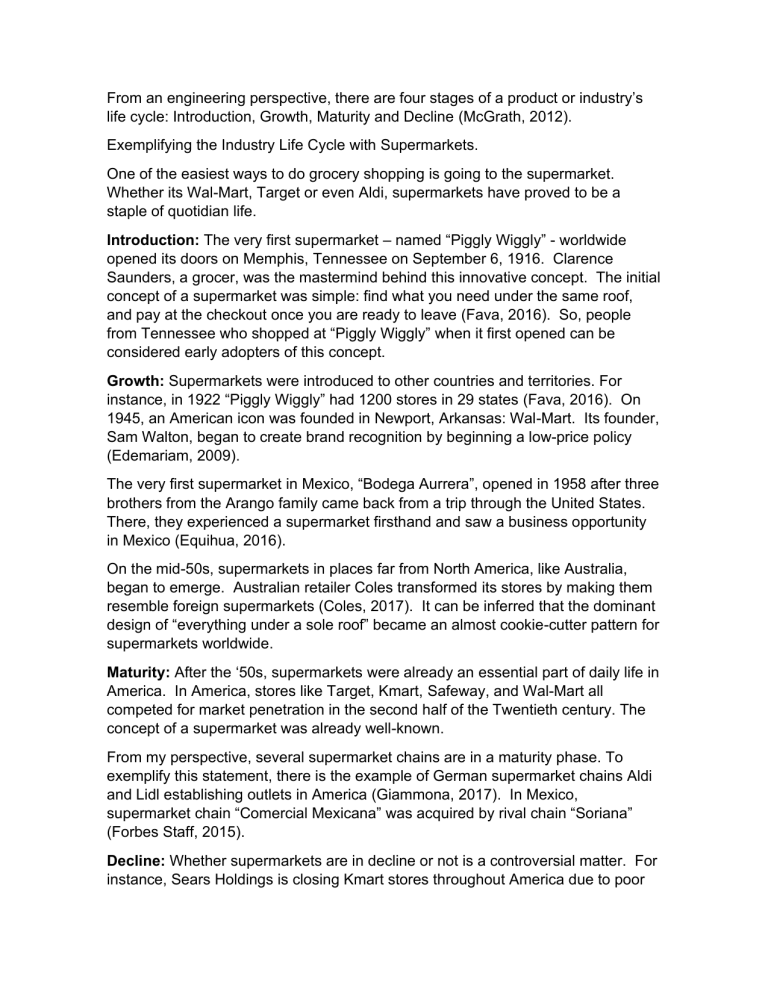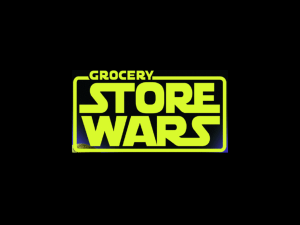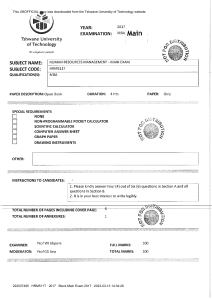
From an engineering perspective, there are four stages of a product or industry’s life cycle: Introduction, Growth, Maturity and Decline (McGrath, 2012). Exemplifying the Industry Life Cycle with Supermarkets. One of the easiest ways to do grocery shopping is going to the supermarket. Whether its Wal-Mart, Target or even Aldi, supermarkets have proved to be a staple of quotidian life. Introduction: The very first supermarket – named “Piggly Wiggly” - worldwide opened its doors on Memphis, Tennessee on September 6, 1916. Clarence Saunders, a grocer, was the mastermind behind this innovative concept. The initial concept of a supermarket was simple: find what you need under the same roof, and pay at the checkout once you are ready to leave (Fava, 2016). So, people from Tennessee who shopped at “Piggly Wiggly” when it first opened can be considered early adopters of this concept. Growth: Supermarkets were introduced to other countries and territories. For instance, in 1922 “Piggly Wiggly” had 1200 stores in 29 states (Fava, 2016). On 1945, an American icon was founded in Newport, Arkansas: Wal-Mart. Its founder, Sam Walton, began to create brand recognition by beginning a low-price policy (Edemariam, 2009). The very first supermarket in Mexico, “Bodega Aurrera”, opened in 1958 after three brothers from the Arango family came back from a trip through the United States. There, they experienced a supermarket firsthand and saw a business opportunity in Mexico (Equihua, 2016). On the mid-50s, supermarkets in places far from North America, like Australia, began to emerge. Australian retailer Coles transformed its stores by making them resemble foreign supermarkets (Coles, 2017). It can be inferred that the dominant design of “everything under a sole roof” became an almost cookie-cutter pattern for supermarkets worldwide. Maturity: After the ‘50s, supermarkets were already an essential part of daily life in America. In America, stores like Target, Kmart, Safeway, and Wal-Mart all competed for market penetration in the second half of the Twentieth century. The concept of a supermarket was already well-known. From my perspective, several supermarket chains are in a maturity phase. To exemplify this statement, there is the example of German supermarket chains Aldi and Lidl establishing outlets in America (Giammona, 2017). In Mexico, supermarket chain “Comercial Mexicana” was acquired by rival chain “Soriana” (Forbes Staff, 2015). Decline: Whether supermarkets are in decline or not is a controversial matter. For instance, Sears Holdings is closing Kmart stores throughout America due to poor financial results and underwhelming sales (Berger & Peterson, 2017). With online retailers like Amazon experimenting with innovative ways of grocery shopping - like shopping through the internet and picking up the purchase at a certain time (Heller, 2017)-, the position of supermarkets will prove an interesting case study in the years to come. From the example, it can be inferred that Mr. Saunders implemented some protoproject management to his concept. He saw the business opportunity by analyzing what customers desired from their shopping experience as he previously worked as a clerk for a general store (Fava, 2016). Saunders was aware of the requirements and the financial implications of his idea. Once he settled all the variables, he proceeded to execute his idea by opening his own supermarket. He controlled how the idea would result by analyzing the performance of his supermarket. Finally, his business expanded to other places in America. Replicas of his idea emerged. References: Berger, A. & Peterson, H. (2017). MORE STORE CLOSINGS: Sears is closing 43 more stores — see if yours is on the list. Retrieved from http://www.businessinsider.com/ Coles. (2017). Where it all began. Retrieved from https://www.coles.com.au/ Edemariam, A. (2009). It all began in a small store in Arkansas... Retrieved from https://www.theguardian.com/ Equihua, A. (2016). El reto del primer supermercado en Mexico [The challenge of the first supermarket in Mexico]. Retrieved from http://instintoemprendedor.com/el-reto-del-primer-supermercado-en-mexico/ Fava, F.A. (2016). The opening of the first supermarket in the world: Memphis, Tennessee (USA) - September 6, 1916. United States of America: David F. Miller Center for Retailing Education and Research - University of Florida Gainesville (USA). Forbes Staff. (2015). Soriana acuerda la compra de Comercial Mexicana [Soriana agrees to acquire Comercial Mexicana]. Retrieved from https://www.forbes.com.mx/ Giammona, C. (2017). Aldi and Lidl Take Supermarket Battle to the U.S. Retrieved from https://www.bloomberg.com/ Heller, L. (2017). Amazon Hits The Gas On Grocery Concept. Retrieved from https://www.forbes.com/ McGrath, R. N. (2012). Project-driven Technology Strategy. United States of America: Project Management Institute, Inc. (PMI). Â Hi Mr. Cliff! First and foremost, thank you for sparking the discussion! Sure, I have seen Amazon’s Go concept in the past. It is quite a twist for the conventional experience of shopping at brick-and-mortar retailers. However, execution of the idea at a nationwide scale remains an eerie idea for me. Amazon’s decision to acquire Whole Foods does not surprise me that much. Logistically, it would mean that 460 stores across the US, Canada and the UK (Wingfield & de la Merced, 2017) are now distribution points for Amazon’s grocery retailing effort. This can be further explained with Microeconomics, specifically with Consumer Theory. With its Gross Domestic Product increasing 1.4% in the first quarter of 2017 (Bureau of Economic Analysis, 2017), it can be inferred that the United States of America is facing a moment of steady growth in terms of economy. Furthermore, it is also possible to state the income of the American people allows them to afford normal goods. Normal goods are goods of superior quality available in the market that consumers are more likely to purchase when they perceive an increase on their income (CFA Institute, 2017). Now, organic products like the ones sold by Whole Foods are perceived as premium by American consumers due to pricing, branding and packaging (Jaenicke & Carlson, 2015). Therefore, American consumers, with more cash to spend, are prone to consume premium products such as the ones marketed as organic. I can infer current segment leaders (Wal-Mart et al.) are aware of the situation, reason why they are trying to innovate and offer products akin to the ones sold by the newcomers. In a sense, those segment leaders are being sent “back to the drawing board”, or in this case, back to the Initiating stage of the Project Management Life Cycle. For them, an innovative, new competitor threatening their market shares is a Business case. Going back to the Engineering perspective of the industry, it is possible to conclude that the American supermarket industry is in the maturity stage. New competitors, like Amazon, Aldi and Lidl are injecting “new blood” to the industry. The cases for American supermarkets in decline particularly Kmart - are segregated and are merely a result of internal mismanagement. Class, I am more than eager to read your thoughts and ideas on the topic! Regards, Lenny Aguilar Ruiz References: Bureau of Economic Analysis. (2017). U.S. Economy at a Glance: Perspective from the BEA Accounts. Retrieved from https://www.bea.gov/newsreleases/glance.htm CFA Institute. (2017). Demand and Supply Analysis: Consumer Demand. Charlottesville, VA: CFA Institute. Jaenicke, E. C., & Carlson, A. C. (2015). Estimating and Investigating Organic Premiums for Retail Level Food Products. Agribusiness, 31(4), 453-471. Winfield, N. & de la Merced, M. (2017). Amazon to Buy Whole Foods for $13.4 Billion. Retrieved from https://www.nytimes.com/






